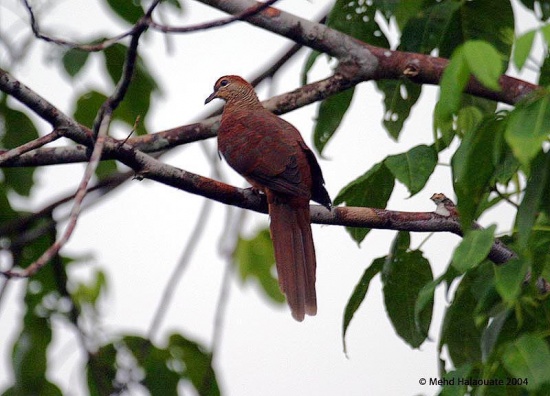| This article is incomplete. This article is missing one or more sections. You can help the BirdForum Opus by expanding it. |
Alternative name(s): Amboina Cuckoo Dove, Pink-breasted Cuckoo Dove
Identification
40 to 43 cm
- Rich rusty-brown
- Very long tail
- Short wings
Male: has a slight rose/green wash on the neck
Distribution
Found from Sulawesi east over Indonesia (including Moluccas) to New Guinea, Bismarck Archipelago, D'Entrecasteaux Archipelago and Louisiade Archipelago.
Taxonomy
Formerly treated conspecific with Brown Cuckoo-Dove from Australia.
Subspecies
There are 15 subspecies[1]:
- M. a. sanghirensis: Sangihe, Siau, Tahulandang, Ruang and Talaud islands
- M. a. albicapilla: Sulawesi, Banggai, Tukangbesi and adjacent islands
- M. a. batchianensis: Northern Moluccas
- M. a. amboinensis: Southern Moluccas (Buru, Seram, Ambon and Seram Laut)
- M. a. keyensis: Kai Islands (south-eastern Moluccas)
- M. a. doreya: North-western New Guinea and western Papuan islands
- M. a. maforensis: Numfor Island (Geelvink Bay off northern New Guinea)
- M. a. griseinucha: Meos Num Island (Geelvink Bay off northern New Guinea)
- M. a. kerstingi: Northern New Guinea (Mamberano to Astrolabe Bay) and Yapen Island
- M. a. goldiei: Coastal southern New Guinea (Merauke region to Milne Bay)
- M. a. meeki: Manam Island (off north-eastern New Guinea)
- M. a. carteretia: Bismarck Archipelago (except New Hanover) and Lihir Island
- M. a. huskeri: New Hanover (Bismarck Archipelago)
- M. a. cinereiceps: D'Entrecasteaux Archipelago
- M. a. cunctata: Louisiade Archipelago
Habitat
Woodland, scrubs and rainforest regrowth areas, open places of low vegetation but can been found in thick rainforests and in the highlands. Observed at heights around 400 mtrs.
Behaviour
They are social birds, often seen in pairs or groups. They are nomadic, dependent on food supplies.
Diet
The diet includes berries.
Breeding
The breed in spring and summer; a flat platform of sticks and vines nest is built, either in a fork of a tree or on top of a low tree. The clutch consists of one creamy-white egg.
References
- Clements, JF. 2011. The Clements Checklist of Birds of the World. 6th ed., with updates to August 2011. Ithaca: Cornell Univ. Press. ISBN 978-0801445019. Spreadsheet available at http://www.birds.cornell.edu/clementschecklist/downloadable-clements-checklist
- Avibase
- Wikipedia
Recommended Citation
- BirdForum Opus contributors. (2024) Slender-billed Cuckoo-Dove. In: BirdForum, the forum for wild birds and birding. Retrieved 27 April 2024 from https://www.birdforum.net/opus/Slender-billed_Cuckoo-Dove




